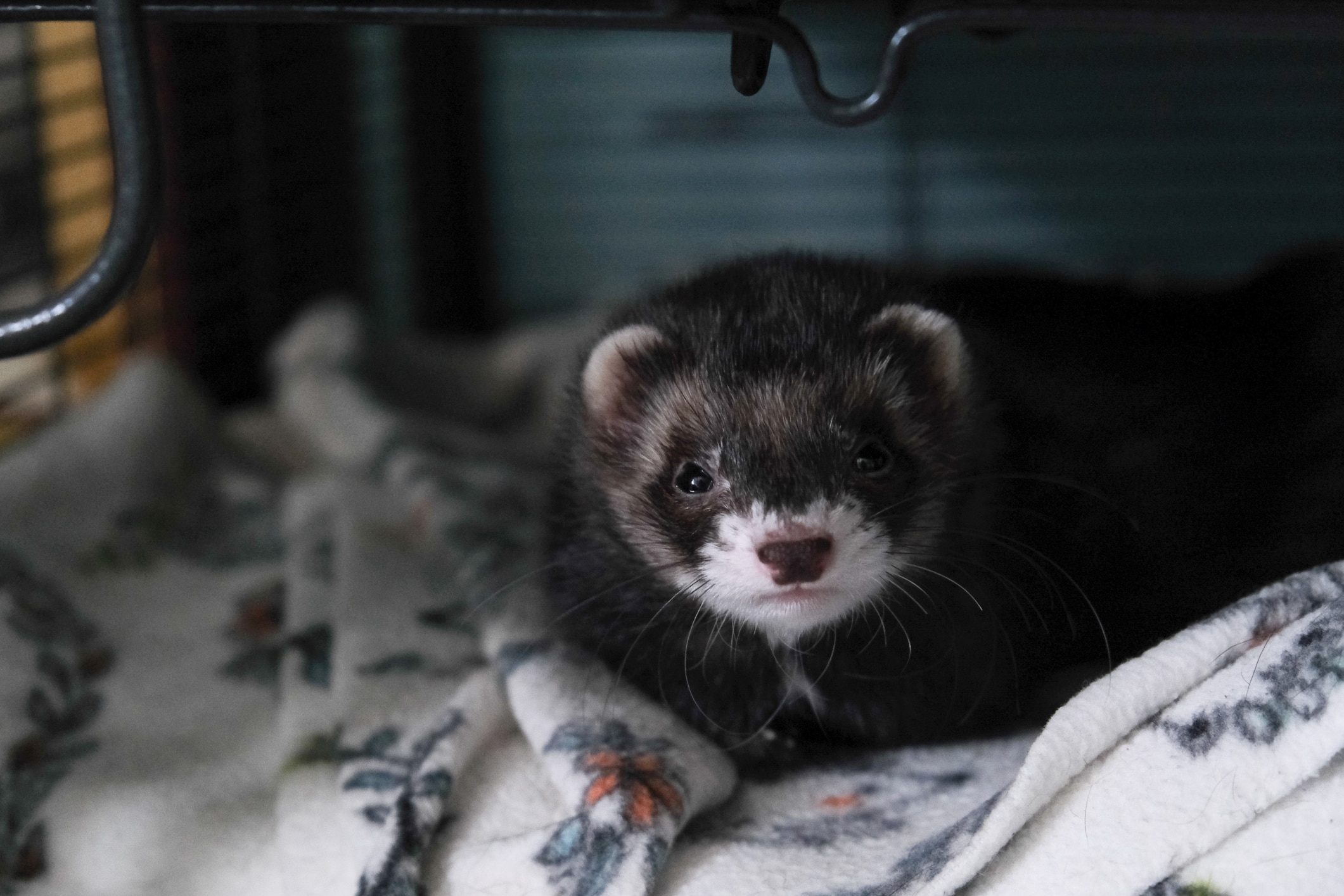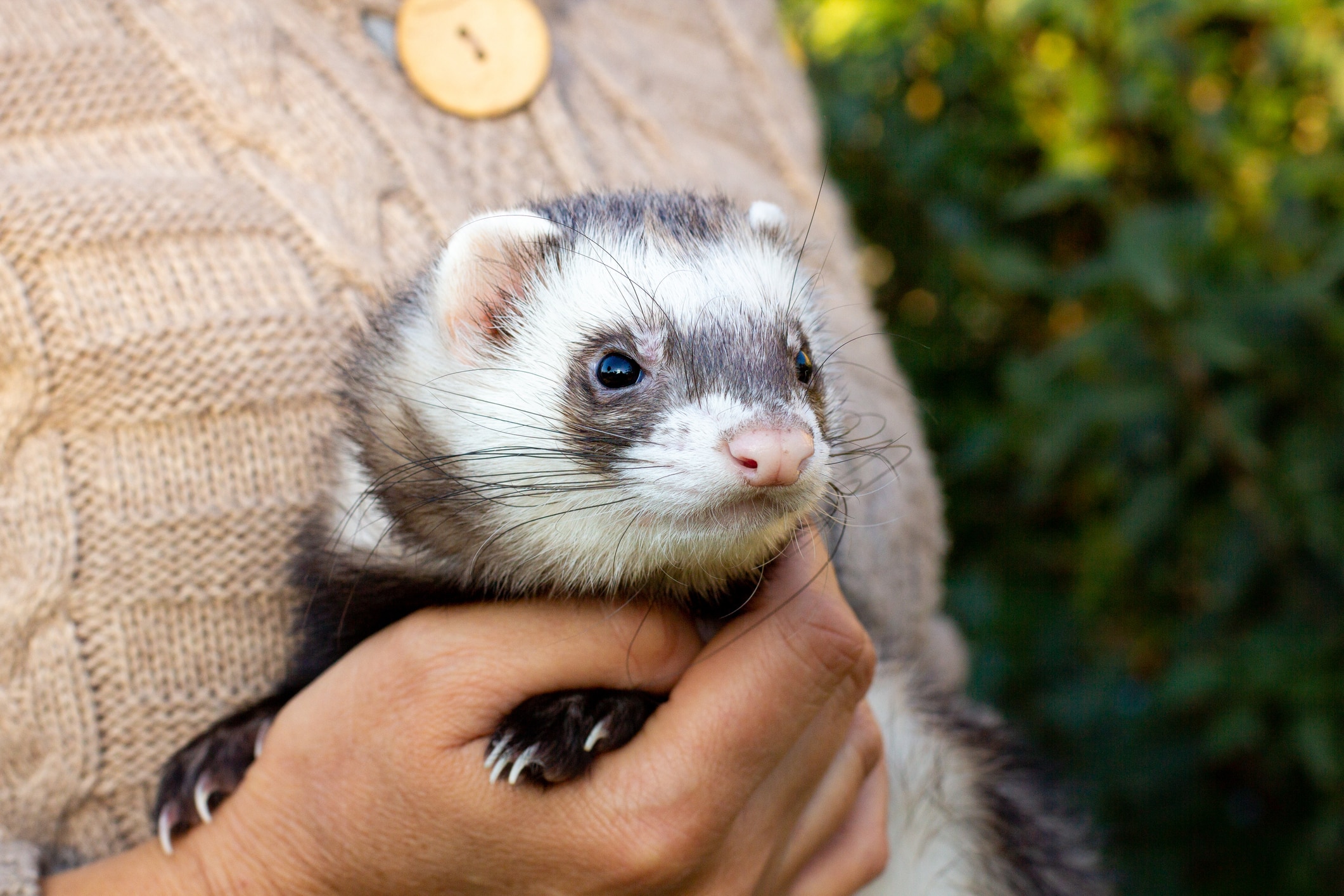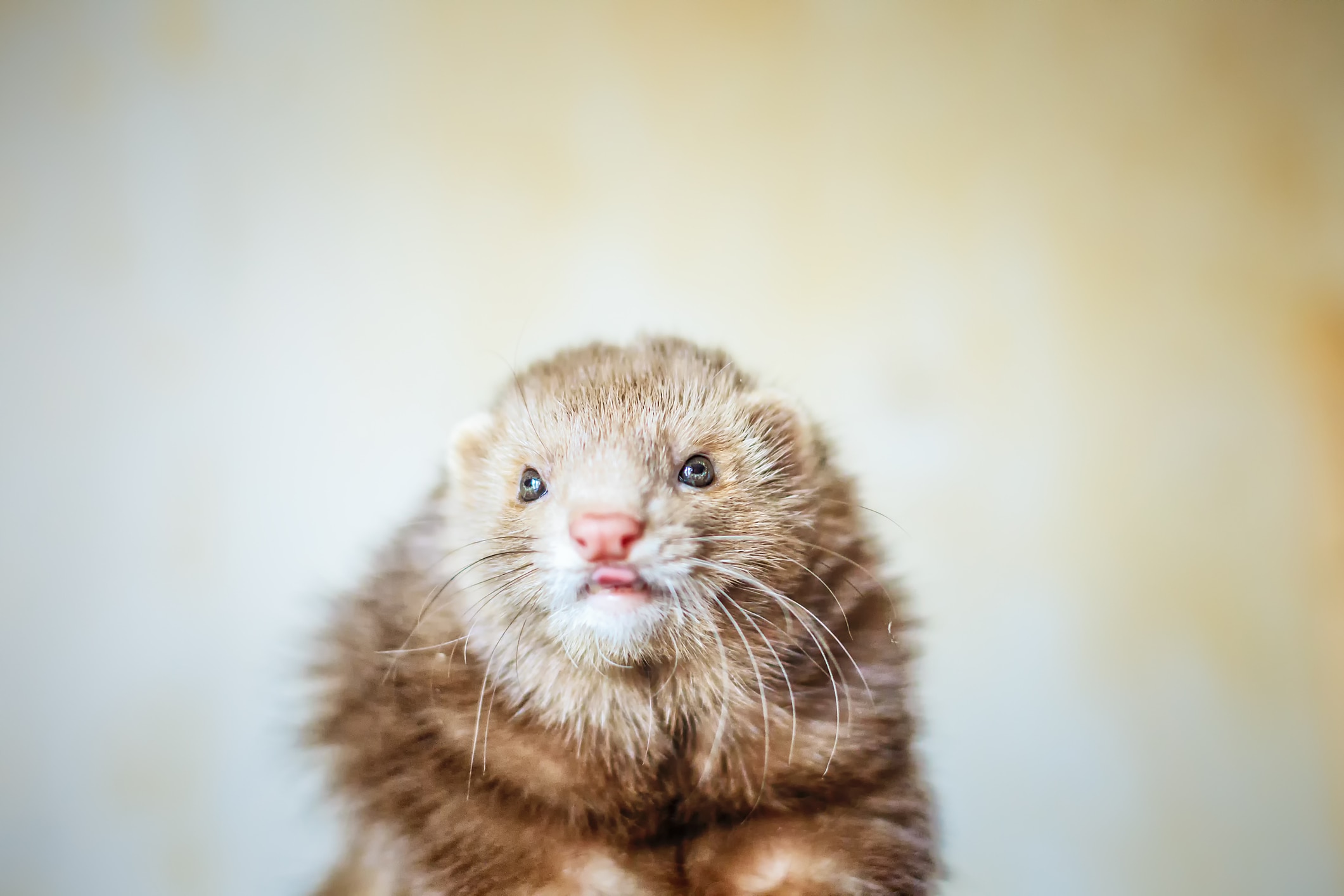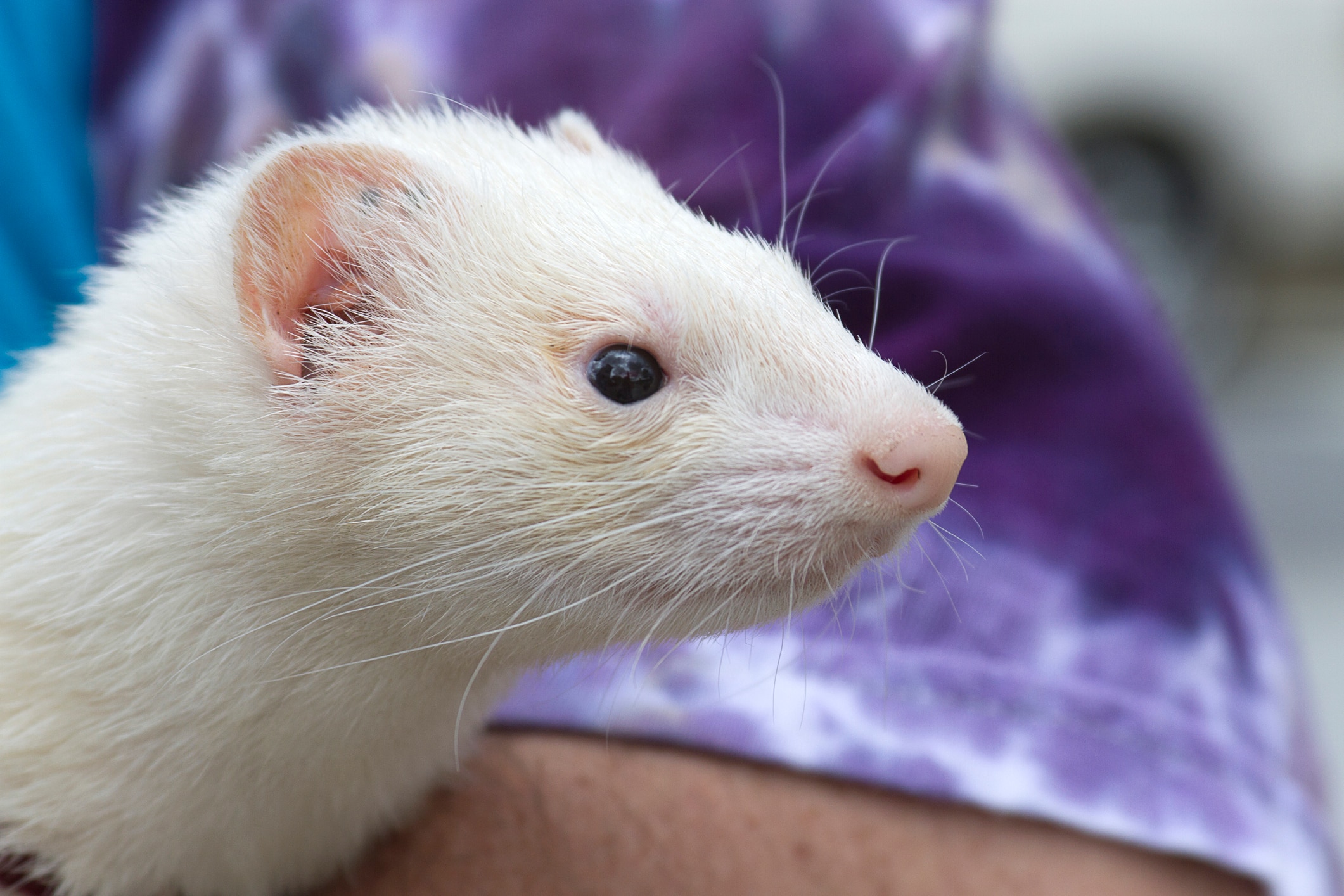Ferret Colors, Markings, and Patterns
gjohnstonphoto/iStock via Getty Images
Ferrets are social and curious, making them entertaining companions. The name "ferret" is derived from frittus, a Latin word meaning "little thief," and they live up to their name! Ferrets are known to stash away small items; in addition, most ferrets have mask-like markings on their faces, making them look like little bandits.
Unlike dogs or cats, there’s only one breed of domesticated ferret, the Mustela putorius furo. But that doesn’t mean that every ferret looks the same—there are many different ferret colors and patterns these pets can sport.
Ferret Colors
Currently, the American Ferret Association recognizes eight standard ferret colors. To characterize your ferret's coat, you should follow a three-step process:
-
Identify the standard color of your ferret.
-
Identify the fur pattern.
-
Identify any white markings, if your ferret has them.
1. Albino Ferrets

Both the undercoat and the guard hairs (top/outer layer of the coat) are white to cream in color in albino ferrets. The white ferret's eyes are a bright ruby red, and their nose is pink. Albino was one of the two first reported colors in ferrets.
2. Black Ferrets

Black ferrets have black guard hairs and a white undercoat. Sometimes, a black ferret may have a slight golden tone to their undercoat. The ferret's eyes and nose are black or nearly black. In some instances, a ferret's nose may be speckled black.
3. Black Sable Ferrets

Similar to black ferrets, black sable ferrets have a white undercoat and black eyes. However, the guard hairs are dark ash in color and have a black gloss-like shine. The nose may be a solid black or brown, but mottled and speckled black or brown is also possible.
4. Champagne Ferrets

A champagne ferret’s guard hairs are tan or a diluted chocolate brown. The undercoat is a white to cream color, but not yellow. A ferret with this coloring has dark brown or burgundy eyes, and their nose can vary from beige to pink, or a mixture of both.
5. Chocolate Ferrets

These brown ferrets have milk chocolate guard hairs with a white undercoat. Typically, chocolate-colored ferrets have brown eyes, but burgundy eyes are also possible. Noses are pink, beige, or a mix of both.
6. Dark-Eyed White ("DEW") Ferrets

Those with dark-eyed white or "DEW" coloration look very similar to Albino ferrets, with white or cream guard hairs and undercoats, but have black eyes. These ferrets are associated with deafness and have decreased in popularity.
7. Sable Ferrets

Sable is the most common ferret color, and it was one of the two first known colors in ferrets. The guard hairs are a warm brown color and their undercoat is white, cream, or light golden. Sable ferrets will typically have brown or almost black eyes and light brown noses. ›
Ferret Markings
Along with having a primary color, your ferret may also have white markings. These can be present in any of the eight standard colors, except in dark-eyed white and albino ferrets. Currently, there are five types of markings a ferret may have:
-
Bib—a white patch of fur under the neck
-
Mitt—white markings on the feet, extending up to the ankle. If a ferret has mitt markings, a bib marking will also likely be present
-
Points—white markings on a ferret's shoulders, legs, tail, and mask
-
Roaning—white guard hairs mixed within the coat, giving a "salt and pepper" appearance throughout a ferret's coat
-
Stocking—unlike mitt markings, stocking markings extend about halfway up the ferret's leg instead of stopping at the ankle
Ferrets can also have mask-like markings on their face. The American Ferret Association recognizes three mask patterns:
-
Standard or Full—a solid color band around and in between each eye
-
T-Bar—a solid color band both around and in between each eye and up to the top of the head resembling an upside-down letter T.
-
V—a thin band of color around each eye and down to the nose resembling the letter V
Ferret Patterns
Now that you can recognize colors and markings seen in ferrets, it’ll be easier to determine what pattern your ferret has. There are nine recognized basic ferret patterns, three of which are also categorized as markings (mitt, point, and roaning).
1. Blaze Ferrets
Any ferret color can have a blaze pattern, except for white ferrets. A blaze pattern is a long stripe on the top of a ferret's head that runs down the back of the neck. Blaze ferrets should also have white tips on their feet or mitt markings and a white tail tip. With this pattern, you may also see bib and roaning markings in addition to white patches of fur on the knees.
2. Mutt Ferrets
A mutt pattern can contain spots, roaning, and other patterns. Typically, mutts will have multiple colors without a distinct color pattern.
3. Panda Ferrets
A panda pattern can be seen in any coat color (except in white ferrets). Panda ferrets have an almost entirely white head with darker fur around the shoulders and hips. Panda ferrets should not have a mask, but some will have small rings of color around the eyes and colored markings on the ears.
4. Solid Ferrets
Once again, this pattern may be seen in any coat color besides white. The guard hairs should be 100% the same color, with no white hairs present. This gives the appearance of one solid color through the coat. Solid ferrets will typically have standard or T-bar masks. The solid pattern is considered the third most common pattern seen in ferrets.
5. Standard Ferrets
Standard patterns are the most common pattern in ferrets. Any coat color—excluding white—can have a standard pattern. This pattern is similar to the solid pattern but with less color concentration. White guard hairs may be seen in this pattern, unlike solid patterned ferrets. Point markings may be seen in addition to mitt and bib markings. Ferrets with a standard pattern can have T-bar masks, but standard masks are the preferred standard.
6. Striped/Patterned Ferrets
A stripe or patterned coat can be any color except all white. Most guard hairs on these ferrets should be white, but they may have some colored hairs throughout the coat. Striped ferrets often have colored spots and/or a stripe going down their back.
7. Mitt Ferrets
Mitt ferrets can be any of the standard coat colors except for all white. As their name suggests, they will have white mitt markings on their feet. Mitt-patterned ferrets will also have white bib markings under their neck.
8. Point Ferrets
Point patterns can be seen in any standard color besides white, but the pattern may vary from pattern to pattern. Black, sable, black-sable, chocolate, and cinnamon-colored ferrets will have a thin “V” mask if they have a point pattern. Champagne-colored ferrets may have a thin “V” mask, but they may not have a mask at all. All point patterned ferrets no matter the color will show an obvious difference between the coat color and points. Points may be seen on a ferret’s shoulders, legs, and tail in addition to the mask.
9. Roaning Ferrets
Roaning patterns can be seen in any colored ferret, except for all white ferrets. To be considered a roan pattern, 40–60% of the guard hairs on the body and points should be white. The main coat color should be evenly spread throughout the body, giving a “salt and pepper” effect.
Caring for Your Ferret's Fur
Ferrets are naturally clean animals and groom themselves often. They'll only need to be bathed once a month using water and ferret-safe shampoo, like Marshall's tear-free ferret shampoo.
They shed twice a year, and should be combed during these times to remove loose fur. Use a fine-toothed comb or soft-bristled brush, such as the one found in Ware® Pet Products' Grooming Kit.
References
Newman, C., et al. The Function of Facial Masks in ‘Midguild’ Carnivores. Oikos, vol. 108, no. 3, pp. 623–33. JSTOR. 2005.
Ferret Colors and Patterns. American Ferret Association
Grabolus D, Wacławik P, Zatoń-Dobrowolska M. Genetic Basis of Coat Colour Inheritance in Ferrets (Mustela Putorius furo): Pedigree Analysis. Acta Scientiarum Polonorum Zootechnica. 2020.
Medicine C. Fun Ferret Facts. FDA. Published online 2020.
Ferrets | Department of Natural Resources and Environment Tasmania. nre.tas.gov.au.
Breed Standards. ferret.org.
